Concert Photography Tips from a Newbie
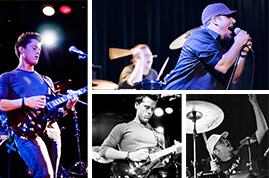
It's always good to hear tips and techniques from seasoned photographers. But sometimes they forget about the “simple” things that beginners need to know, opting for more advanced topics. I had the opportunity to photograph a concert type of event for the first time in my photography career. Sure, I had read through the concert photography tips available on the web, but I still had to learn many things as I went.
On February 28, 2009 I ventured up to Hollywood for a little performance at the Whisky a Go Go. The main reason I went was because my pal Bryan was playing that night with his band, The Scarlet Paradigm. Playing right before them was Chico and the Sapphires, and they both totally rocked! Seriously, check out their pages and listen to their tunes. These guys are good. You can also see my Flickr sets for both The Scarlet Paradigm and Chico and the Sapphires.
Rather than offer up advice on the topic as if I actually knew it well, I offer up a few concert photography tips from a beginner's perspective. Here's what I learned in just a few minutes of shooting that night.
DO YOUR HOMEWORK
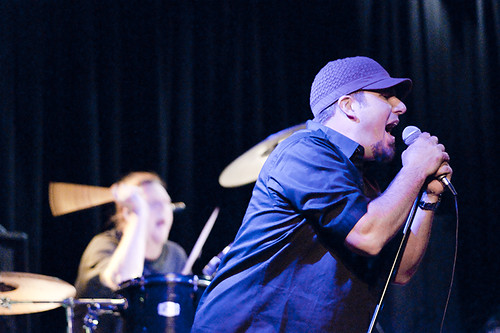
Before you go photograph your first concert, read up on the tips and tricks articles out there on the web (I've got a list at the end of this article). Also be sure to scope the venue beforehand or at least talk to somebody that's been there before. Find out if they're photographer-friendly, if you need a special pass, if they allow flash, what kind of space you'll have to work with, and what the lighting might be like. Showing up completely unprepared will only cause a lot of stress and ruin the evening.
BRING FAST GLASS
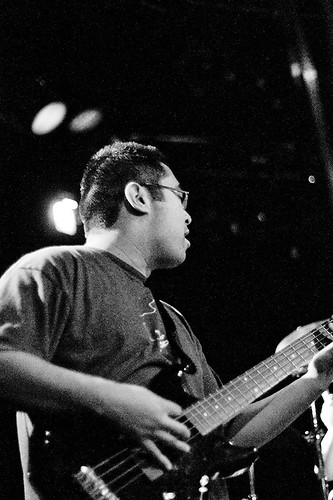
I've seen this tip in just about every concert photography article out there — but for good reason! Concerts are generally dimly-lit and you need all the speed you can get your hands on. I brought my 50mm f/1.4 and my 105mm f/2.8 lenses. The f/2.8 wasn't too bad, but the f/1.4 was noticeably faster. If you don't have really fast glass, you can either borrow some from a friend or even rent one for the weekend. And if all else fails, just bring what you have and make do.
CRANK THE ISO
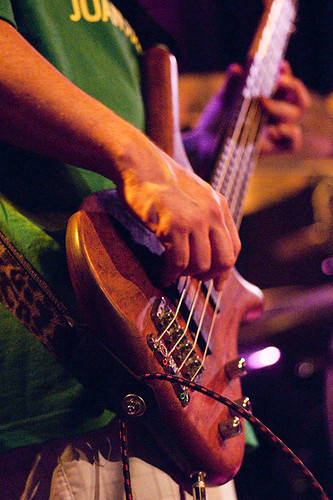
Even if you use fast lenses, you'll still have to crank the ISO to anywhere from ISO800 to ISO6400 (or higher). Using large apertures and high ISO values will allow you to shoot at faster shutter speeds. Depending on the performers, you might need something as fast as 1/250 seconds or faster to avoid motion blur. I ended up shooting 99% of my photos at ISO6400 and I got speeds anywhere from 1/6 seconds to 1/1500 seconds with a majority being in the neighborhood of 1/90 seconds to 1/500 seconds. And yet, probably half of my photos showed signs of motion blur (the bands were very lively).
PACK SMART
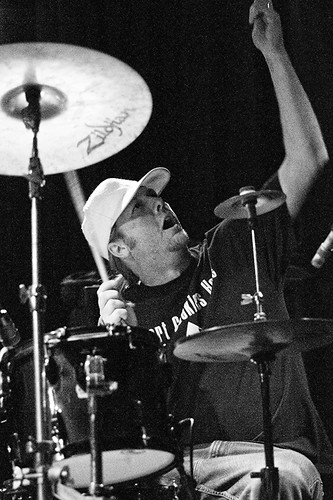
Lots of people go to see bands perform and local venues usually have limited floorspace. Everybody else is there to enjoy the performance, so don't be that person with the giant backpack shoving your way through the crowd. You'll have a hard time moving around and finding spots to shoot, plus you'll be bumping up against everyone with your bag. Bring one or two camera bodies and one or two lenses total. You're going to find good shots with whatever lens you bring and you don't want to be changing gear every couple of minutes. So pack smart.
PUSH YOUR FILM
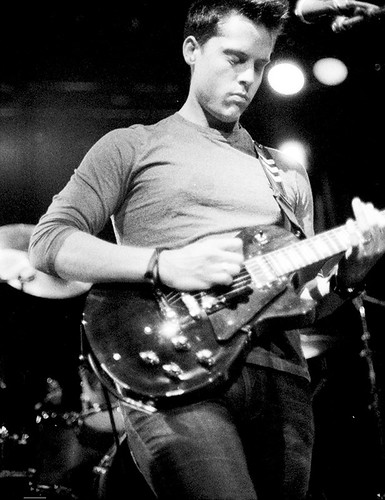
If you decide to shoot some film, just remember that you can push ASA400 film as far as ASA3200 without losing a ton of quality. Just do your research on which film/developer combos will allow you to do this. I shot a roll of Ilford HP5+ (ASA400) at ASA3200 and a roll of Ilford Delta3200 at ASA6400 by push developing with Rodinal.
DON'T BE SHY
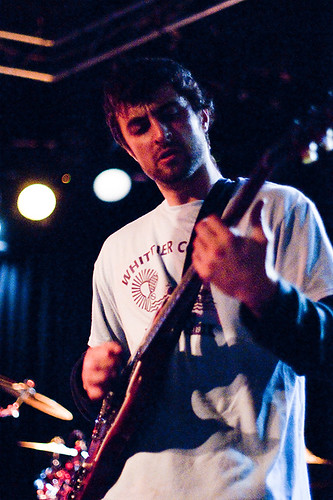
It can feel a bit awkward to push your way in front of people then stand there with a camera in front of your face. But nobody is going to invite you right up to the stage so you can get a shot. Get in there, take a few shots, and move somewhere else. If you keep moving, you won't tick many people off plus you'll get a lot of different angles.
DON'T OVER-PROCESS
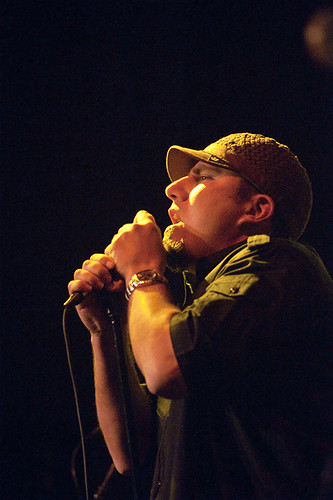
When it comes time to process your photos, just don't over-do it. The lighting will probably provide enough color and contrast to be interesting. Just do a couple things to recover highlights and shadows, reduce noise, and try to show what you actually saw. Converting to black and white is also a good option (due to the noise) and you'll probably have more freedom with your tweaks. Plus you can sometimes get the noise to look like grain if you convert your colors correctly. And if you want to get into Photoshop for a little more creative control, check out these Concert Photography Photoshop Actions.
AND HAVE A GOOD TIME!
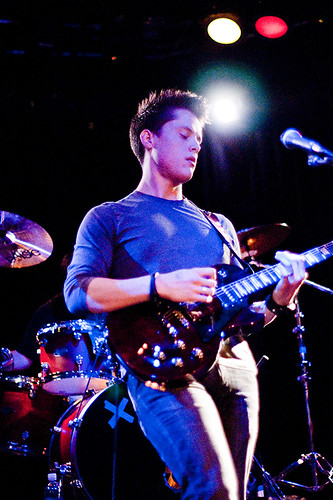
No matter what, be sure to enjoy yourself. The band you're photographing is made up of artists like yourself. Artists like to have people enjoy their work — it makes them feel good inside. So pull the camera away from your face every once in a while and just enjoy it.
FURTHER READING…
I know I didn't cover every single tip and technique for concert photography, so here are a few other articles that dive into other aspects of it.
- More Thoughts on Concert Photography
- How To Photograph Rock Concerts – The Basics
- How To Photograph Rock Concerts – Beyond Basics
- Wide Angle Tips and Tricks
- Three Songs, No Flash
- 6 Tips to Take Great Photographs at Music Concerts
And if you have concert photography tips and/or example photos, drop a comment below! You're a smart crowd and I always enjoy learning new things from the community.
Ryan Holloway
March 17, 2009I don’t know man, I don’t think 6400 was working out for you.
Ryan
https://www.ryanhollowayphotography.com
pieter
March 17, 2009Great introduction into concert photography! I shoot a lot of concerts for our world music blog tropicalidad.be, and I’d like to add these these tips: find the right angle! I work mostly with prime lenses (85mm f/1.8) and in order to compose your shots nicely, you have to move left, right, up & down to get that colorful spotlight exactly were you want it. Start with longer lenses (50mm and up) which will make composing shots easier. Wide angle shots are harder (there are a more elements in your frame) but can deliver spectacular results. One last tip: don’t use your camera as a camcorder. Look at the stage, the light, the artists, their movements and push the shutter at the right time. Although it’s tempting, gambling doesn’t work well here.
You’re welcome to have a look at my recent concert photo’s (on flickr).
Brian Auer
March 17, 2009@Ryan Well, I’d rather get photos with a little extra noise than photos with a little extra motion blur. Like I said, the venue was very dark and the bands were very energetic. After taking a dozen shots at ISO1600 and ISO3200 and reviewing, I decided that the motion blur was unacceptable.
@Pieter Wow, lots of great photos showcased on your site and your Flickr! Good tips on the lens selection too. I actually brought my 10-20mm lens along, but I never even mounted it. I was finding decent compositions with the 50 and 105. The 105 was a bit tight, but good for a few detail close-ups.
Ryan Holloway
March 17, 2009I hear you Brian, I find its best if your close to prefocus right behind the mike if your shooting with a 50mm or 85mm at about 2.0, getting the focus ready will save you a bunch of time and you can gauge how fast you can set your shutter reliably, here are some examples of stuff I have shot.
https://ryanholloway.smugmug.com/Band%20Shots
Good shots, just don’t know if I’d push that high, with practice I usually don’t have to go above 1600
Ryan
https://www.ryanhollowayphotography.com
Joanie
March 17, 2009Since shooting in dark venues comprises the bulk of my photography (I’m way behind on uploads to Flickr), I can tell you what I’ve come up against regarding various venues (especially) here in San Diego. You won’t always be allowed to bring in two camera bodies. Places like the Belly Up will either ask you not to shoot at all or you’ll only be allowed to bring in one body and a lens or two (unless you have everything set up in advance and even then, things change at the last minute). You also don’t always get to move around a lot. Again, using the Belly as a prime example, the crowd at the stage packs in tight and very often you have to fight just to keep the one spot you do have. Depending on the type of music, sometimes that struggle to keep your spot can get downright nasty. Worse if the patrons are majorly drunk. Bring as little as possible with you to the front of the stage and try to get the best spot you can before the performance begins. if you end up not being able to move around, at least you’ll have that prime location.
ramin
March 18, 2009I’ve been shooting several shows at a local club. Last weekend I finally saw that there is such a thing as too close 😉
But bringing a wide-angle in smaller venues is a good option, you can get some really interesting shots with one.
I agree that fast lenses are needed, but I’ve been fine with 2.8 and 4 so far. I also limit myself to max ISO 1600 since I can’t stand the noise above that level (on a 30D).
One hint that I’d add is finding a solid place to stand. Or being solidly built. When you’re in the mosh pit you will be bumped into a lot. I also agree with Joanie that come early and get a good spot, most likely if you move you won’t get anything as good if you’re in the pit. I’d also recommend limiting yourself to just one body and a lens or two if you’re in the pit. Anything else will be at major risk with revelers bouncing around.
And a last hint. Even though you should enjoy yourself, don’t try to mosh or bop with the music while trying to get a shot. It will be ruined. Trust me, I’ve noticed it often enough 😉
Dani
March 18, 2009thanks for this. Just got my hands on a D700 and it worked out much better than what I was shooting with. Lots of noise in the pictures but I would rather have noise than under exposing. And generally most of the bands I shoot love the noise in the pictures. Great shots!
Rohit
March 18, 2009Remote flash.
Thanks for the post. I too recently shot a friend’s band at a very small bar. even at 1600 h.2 with a 1.8, there wasn’t enough light capture much. The venue was flash friendly so I was able to put a remote flash set to 1/4 power above the air vent in the middle of the open floor on a fairly wide spread. there was little ambient to begin anyway so i was able to simply set at about 1/200th and just play with the aperture till i was happy on a relatively low ISO.
I agree with the post and the comments that moving around getting in close and choosing angles. With just one light source and fixed lenses i was forced to move around for interesting contrasts and views.
That was my first band/concert shoot. i’ll definitely learn from the experience and will take ideas from this post. thanks again.
Michael Klayman
March 18, 2009Hi Brian,
I shoot at a lot of the smaller venues here in San Diego, and fast glass, small bag, and getting to the best spot before the show starts are all important. I’m out at shows a few times a month, maybe we’ll see each other at some point.
pawoli
March 19, 2009Hi Brian,
Nice article, enjoyed it.
It seems that we both had to shoot small venues 😉
I did the same for a friend a few weeks ago, I didn’t had a fast lense but a 18-200 VR and a D700, all this allowing me to go into very high iso and still be able to "save" some shots.
You can have a look at the results over here in thos sets :
https://www.flickr.com/photos/pawoli/sets/72157615620478618/
https://www.flickr.com/photos/pawoli/sets/72157614389859006/
https://www.flickr.com/photos/pawoli/sets/72157615619113582/
Chris Casella
March 19, 2009I am happy to see someone out there with a newbie perspective. I almost forgot what it was like just starting out and you are right, people should have checklists and do research on certain things. I agree with most of this, but there are some things that do not hold true. Yes, in a club, the light will be dim if not nil. Most clubs will allow flash. If not using flash, yes, unfortunately, you will have to crank the iso, but there is plenty of noise reduction software out there, and it is getting really good. As for pushing film, having worked in a commercial lab (not mini lab photo mat crap) for over a decade, pushing film does lose a ton of quality. Your shadow detail goes right out the window. Especially if you are talking about 400 to 3200 (3 full stops). Once you get past the small clubs and start shooting in larger venues, you do not have to crank the iso and open all the way up. I have shot bands at 400 iso at 1/250 of a second at f6.3-f8. Every venue, every show, every situation is different. I think it sucks that you could not find better newbie tips online. I answer peoples emails all the time concerning gear and shooting concerts and shows. You should also consider manually controlling the light balance if at all possible. Most every show you shoot will be tungsten so dial it down to say, 3200K, to get rid of some of the bad color. There is a lot of info out there and I think the best advice is to ask someone who is in the business professionally if you need to know something or have questions. Some pros wont answer or will be dicks, but I have met a lot of people I idolize and speak to them whenever I have a question or need help.
Bryan Villarin
March 19, 2009Thanks for coming to our show, Brian! We’re so stoked you like our music.
I wrote about a couple concerts I photographed last year:
* Finch concert at the UC Forum
* [Recap] Chiodos concert at The Glass House
Marah Anderson
March 19, 2009Great article and photos! My tips would be to watch out for beverages that might spill onto your camera when the crowd gets wild. And, if shooting on film in a dimly lit place, overexposing a bit more than what the meter tells you will usually get you the right exposure.
Tasha
March 22, 2009Great tips, Brian. I think you did a great job getting the basics down – especially the doing your research, fast glass, and cranking the ISO. I completely agree that it is more important to stop the motion and get slightly noiser pictures with higher ISOs – you can fix grain, but a blurry picture is impossible to clear up. I don’t know if you needed QUITE as fast shutter speeds (my standard speeds are between 1/80-1/160 – but I also regularly shoot at 6400ISO and even 12800ISO).
Another tip I might add is to bring a band member or tour manager’s cell number with you to the venue if you are being put on the list for a photopass, in case there is a problem with the list. It also helps to bring a printout of an email that states you will have a photopass waiting at will call, if possible.
Are you planning on shooting more concerts?
And thanks for the linkage, too!
Brian Auer
March 22, 2009@Ryan For sure, 1600 is certainly a number I’m more comfortable with. Once I hit 3200 on my camera, the noise really starts to jump out. And 6400 is only used as a last resort.
@Joanie Thanks for the heads-up on the San Diego venues. I haven’t hit any of them yet, but I might give it a go this summer.
@Ramin Yeah, there were a few times when I was tempted to bring out my wide angle lens, but I was concerned about the low light and I stuck with my fast lenses.
@Dani Good point — the noise kind of gives the photos a grungy look suited to rock bands (especially in b/w).
@Michael If I manage to get out there and do some local shows I’m sure we’ll bump into each other! I’ll be the guy with the Sony dSLR and probably a film camera hanging around my neck!
@Pawoli Great shots! Very impressive!
@Chris Yeah, this was the first time I pushed the film that far. I did notice that the shadows were gone and the highlights were pushing past the limits too. The dynamic range of the film goes right down the drain. And for the digital WB, I found that tungsten was pretty close to the ideal mark.
@Bryan For sure! I hope to make a few more of your shows this year. I wouldn’t mind hitting another Chico show too! You guys should hook up and play together again.
@Tasha Thanks! I’d like to shoot more of this stuff — I’ll probably hit a few more Scarlet Paradigm shows, maybe some San Diego venues too. I sure wouldn’t mind being able to shoot a “big” concert, but I’m sure you need to have all sorts of contacts and credentials to get a press pass. I’m actually going to see NIN in May down in Chula Vista — wouldn’t THAT be fun to shoot?!!
Pancho
April 23, 2009Nice tips! Thanks!
I had to photogaph a concert a few days ago (I’m not even a newbie). I had a D40 with 50-150 lenses and couldn’t took a single decent photo: too far away, no flash allowed. Useless pictures… until I set the camera in sports mode. That helped a lot!
Stephanie
November 7, 2009Im just a junior in high school in need of some serious help with a photography project. The schools provided me with a 50mm Nikon camera and a roll of iso 400 film. My grumpy teacher has hounded us on depth of field, and how our photos are flat. I dont understand how to set up the depth of field, or f:stop or shutter speed. I NEED HELP. concerts later this week. if you can help, id appreciate it before then.
Brian Auer
November 7, 2009Lower numbers on the f-stop will give you a shallow depth of field. With low light available at most concerts, you’ll need to shoot close to wide open anyway, and you’ll have to meter the scene to determine the shutter speed. If it’s a dark venue, ISO400 will be too slow. Depending on the film, you might be able to shoot it at ISO800, 1600, or 3200. Shooting at a higher ISO will give you better options for your shutter speed, but you’ll lose image quality (unless you want it to be really grainy).
Simon
November 16, 2009i use the most time on the Rock Concerts in smal and dark clubs lenses with Apertures from 1.2 till 2.8 and shutter speeds between 1/80 and 1/250 sec. on bigger stages with good light is it a bit different.
Greg Taylor
January 5, 2010Concert photography is so unpredictable – which is what makes it great. When I’m given photo credentials by a band the first thing I do is to view some live photos of them. This allows me to get a sense for how they hold their guitar etc., the stage set up and maybe how they interact with each other.
Lighting is always a fun challenge. One night at a club my 24-70 2.8 may be perfect another night I may want to shoot with a prime 50mm 1.8 -Typically I always have a game plan when I go to a venue and ultimately it always changes. Know your camera, know your settings, know your subject and then trust your instincts.